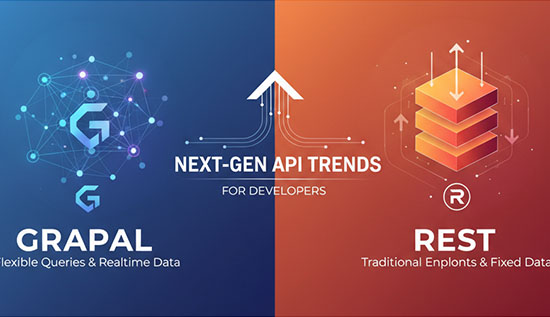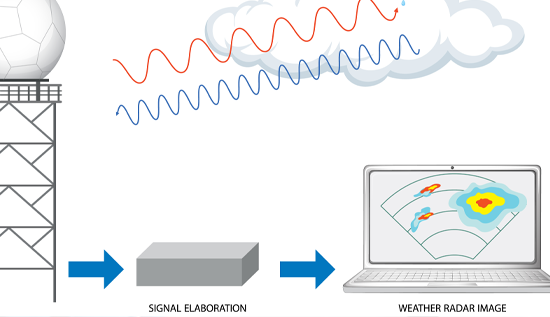GraphQL vs REST: Next-Gen API Trends for Developers

Compare GraphQL vs REST to optimize API performance, scalability and modern application design with best practices for developers.
APIs are the building blocks of modern apps because they make it easy to connect services, devices and platforms in a world where technology is changing quickly. More and more, developers have to choose between using REST APIs and GraphQL for their projects.
Understanding GraphQL vs REST is crucial for building scalable, high-performance applications that meet modern user expectations. This article explores modern API development trends, delves into GraphQL for scalable APIs, examines REST API best practices, and provides insights into next-generation API design strategies.
As the link between the client and the server, APIs make it possible for data to be sent and received easily. REST APIs have been the standard for a long time because they are simple and have reliable request-response structures. REST operates on resources, utilizing endpoints such as /users or /orders and standard HTTP methods like GET, POST, PUT and DELETE.
In contrast, GraphQL, developed by Facebook in 2015, introduces a flexible, client-driven query language for APIs. Unlike REST, GraphQL allows clients to request exactly the data they need, minimizing issues like over-fetching or under-fetching that are common in REST. GraphQL is a popular choice for businesses looking for scalable APIs because of this feature. This is especially true for mobile apps and complex web platforms.
There are big differences between GraphQL and REST. GraphQL lets clients get more than one resource at once, while REST often needs more than one route to get different types of data. For GraphQL questions, the answer can be changed by the client to meet their needs. When you give a REST answer, it can't be changed.
Many times, versioned endpoints are used to deal with changes in REST. But in GraphQL, APIs can change without explicitly versioning. Additionally, GraphQL reduces payload size and improves efficiency, providing a clear advantage in API performance optimization. Understanding REST API vs GraphQL equips developers to design next-gen API architectures that are strong and can handle the needs of these applications right now.
What Are REST and GraphQL?
APIs are what make web apps, mobile apps and microservices work. They connect front-end interfaces to back-end services. REST has been the standard method for years but the rise of GraphQL is transforming modern API development trends. Understanding GraphQL vs REST is crucial for building efficient scalable applications.
REST or Representational State Transfer, is an architectural style that uses standard HTTP methods like GET, POST, PUT and DELETE to interact with resources exposed via endpoints. For instance, developers could use GET to get a person with the ID 123, POST to make an order or PUT to change a product's information.
A lot of people use REST APIs, they use HTTP caching, and they don't store any data, which makes growing easy. Although, REST can cause too much or too little fetching, or it can cause multiple requests to get linked or nested data. Version control can also be hard and route versions like /api/v1/users and /api/v2/users are common.
When Facebook created GraphQL, it offered a new way of doing things. Querying at a single endpoint lets clients specify the exact data they need instead of using multiple URLs. GraphQL also supports mutations to modify data and subscriptions for real-time updates.
For example, a query can get information about a user, their most recent orders and the things in each order all at once. The server only sends back the fields that were asked for, which reduces the size of the message and makes the network work better.
GraphQL is strongly typed, self-documenting and allows API evolution without breaking existing clients. This makes it particularly suitable for applications with complex, nested data structures, multiple front-end clients or real-time requirements.
GraphQL is often better or the same as REST because it can get exact data, type quickly and work in real time. For developers, knowing the pros and cons of each method helps them make smart choices when deciding between GraphQL and REST and planning next-generation API design for scalable high-performance applications.
Modern API Development Trends: Why GraphQL Is Rising
The world of building APIs is changing very quickly. REST has been the usual way to build web services for a long time, but developers now want their APIs to be more flexible, efficient and scalable.
Modern apps, like mobile apps and real-time dashboards, need to be able to get info quickly and accurately, with little network traffic and seamless schema evolution. This shift has propelled GraphQL into the spotlight, making it a key player in next-generation API design.
Understanding why GraphQL vs REST is gaining attention helps developers make informed decisions about which approach fits their applications. From using less bandwidth to making the developer experience better, GraphQL fixes many of the problems with standard REST APIs and adds powerful features like real-time updates and schema introspection.
In what comes next, we'll look at the main reasons why GraphQL is becoming so popular so quickly and how it's changing the best ways to build APIs.
- Flexible Data Fetching: One of the biggest advantages in the GraphQL vs REST debate is how GraphQL handles data fetching. With GraphQL, clients avoid both over-fetching (getting more fields than needed) and under-fetching (needing multiple REST requests). Experts have said that GraphQL "allows clients to request exactly what data they need in a single request." This adaptability cuts down on payload sizes and boosts efficiency, especially on devices with limited speed like cell phones.
- Efficient Network Usage and Performance: Most of the time, you can cut down on round trips by putting all the data needs into a single GraphQL query. Instead of calling multiple REST endpoints to get all the info you need, GraphQL can do it all at once. For instance, in a social app, you might send one GraphQL query that gets the person, their posts, and their comments instead of calling /user/123, /user/123/posts, /post/.../comments one at a time. According to a performance benchmark, GraphQL can reduce bandwidth usage significantly one study observed 67% less data transmitted in typical mobile queries versus REST. Another benchmarking experiment found GraphQL averaged ~320 ms latency on complex queries compared to ~480 ms for REST and used 45% less bandwidth also.
- Schema Evolution Without Versioning: In REST API vs GraphQL, Version control is a common problem for REST. Versioning endpoints (e.g., /api/v1/... → /api/v2/...) is often needed when REST is used, which means that upkeep has to be done twice. In GraphQL, on the other hand, deprecation can happen slowly. You can remove fields while still keeping backward compatibility and when clients are ready, they just stop accessing deprecated fields.
- Better Developer Experience: GraphQL is strongly typed and self‑documenting. Its schema acts like a contract, and tools like GraphQL Playground or GraphiQL let developers explore APIs easily. Because of introspection, the API “documents itself,” reducing manual documentation effort. Front-end teams love how they can iterate without backend changes: as long as fields exist in the schema, they can request new data without asking backend engineers to add new endpoints.
- Real-time Support: GraphQL lets you get changes in real time through subscriptions, which let you send push notifications over WebSocket. This is an important function for modern apps, especially chat apps, live dashboards and multiplayer games.
- Adoption Trends: GraphQL adoption is growing rapidly. According to recent data:
- Enterprise adoption has soared, with a 340% increase since 2023 according to the Apollo GraphQL Developer Survey.
- 67% of companies report improved developer productivity with GraphQL.
- Major companies like Facebook, GitHub, Twitch and Shopify are using GraphQL in production.
These trends underline why GraphQL for scalable APIs is becoming a cornerstone of next-generation API design.
Comparing GraphQL vs REST: Pros and Trade-offs
When evaluating GraphQL vs REST, because developers can make better choices for their apps when they know the pros and cons of each approach. Because it has a lot of set endpoints, REST is great for systems that work with resources. With normal HTTP methods, it's easy to cache REST because each endpoint points to a different file. REST's stateless design makes scaling easier and developers can get started quickly with its mature tools and wide use.
However, REST can face challenges in more complex scenarios. A lot of the time, when data is fetched, it either gets over-fetched (clients get extra fields) or under-fetched (multiple requests are needed to put together related data). It can also be hard to keep track of versions. When the API changes, new endpoint versions often need to be made, which adds to the upkeep work and could lead to confusion among clients.
GraphQL, by contrast, uses a single endpoint where clients can request exactly the data they need. This eliminates over-fetching and under-fetching, reducing bandwidth usage and improving performance. It has a highly typed schema that makes contracts between the frontend and backend teams clear.
Introspection lets APIs document themselves, which makes developers more productive. GraphQL also supports real-time updates through subscriptions, which works great for live panels, chat apps or alerts. GraphQL's schema development is smoother than REST's; fields can be slowly taken out of use without affecting clients that are already using the language.
Despite these advantages, GraphQL introduces complexity on the server side. Implementing resolvers, batching requests, and managing query depth or complexity can require more engineering effort than a traditional REST API. It's also important to think about security.
Depth, cost and rate should be used to stop queries that are very deep or that cost a lot of money. For teams that are used to REST, they need to learn GraphQL's query language, schema design and server code as well. This makes the initial learning curve steeper.
Performance-wise, REST is reliable and well-understood, leveraging mature optimizations like HTTP caching and CDN integration. GraphQL can reduce round trips and payload size, but the server may face higher computational demands to resolve complex queries. Caching is also more challenging in GraphQL, often requiring custom solutions or persisted queries to achieve similar efficiency.
Ultimately, the decision between REST and GraphQL depends on your application’s requirements. REST is best suited for well-defined, resource-centric operations where caching and simplicity are priorities, while GraphQL is great for applications that need to fetch data in a variety of ways, get updates in real time, and have a highly typed schema that changes over time.
Many modern designs use both REST and GraphQL. GraphQL is used for client-driven queries, and REST is used for transactional endpoints. This takes the best parts of both models and makes the worst parts less important.
When to Use REST or GraphQL: A Developer Guide
One of the most practical aspects of GraphQL vs REST: Which API is better for modern apps. Here are some examples and a step-by-step plan to help you decide.
Step-by-Step Decision Guide
- Analyze Data Requirements: There may be fewer trips back and forth if clients often need linked or nested data (for example, user posts and comments). Rest is definitely enough if your API is pretty flat (simple CRUD).
- Evaluate Team Skills & Resources: Do your developers know how to use GraphQL already? Iteration can go faster if the answer is yes. If not, set aside money for learning, designing schemas and devops to handle the complexity of GraphQL.
- Consider Performance & Caching Needs: REST's model may give better speed with less work if HTTP caching is important (CDN, browser caching). For GraphQL, you should plan to improve API speed by batching queries that are persisted and limiting the complexity of queries.
- Plan for Versioning & Evolution: For REST, decide on a versioning strategy (URL versioning, header, etc.). For GraphQL, rely on schema deprecation to evolve your API without breaking clients.
- Security: For REST: Implement standard HTTP authentication, rate limiting and endpoint-based protection. Add cost analysis, query whitelisting and depth limiting to GraphQL to stop malicious or overly complicated requests.
- Real-time Needs: Want to know about events, get live updates or subscribe to your app? GraphQL's monthly plan might be a great fit for you. Real-time might not be needed if REST is used or if polls or webhooks can handle it.
- REST as a scaling strategy: use CDNs, HTTP caching and microservice models. GraphQL: Put money into batching, DataLoader (or patterns that work like DataLoader) patterns, query complexity controls, permanent queries and maybe even schema federation.
Best Practices & Next-Gen API Trends for Developers
Here are best practices and next-generation API trends when making modern APIs, whether they use GraphQL, REST or both.
- Adopt a Hybrid Strategy: CRUD-like jobs that need a lot of resources should be done with REST. GraphQL is what you need to ask, find or work in real time. The best parts of both theories are used together in this method.
- Limit the total cost and difficulty of queries: To avoid bad or poorly written GraphQL queries, it is important to stick to limits on query depth or cost. Cut down on runtime parsing and help with caching by using saved searches.
- Utilize Batching and DataLoader: To prevent N+1 waste per resolver, make your resolver calls in groups. Utilize DataLoader or a comparable pattern to quickly get and keep data at the resolver level.
- Toggle on the cache layers: Utilize HTTP cache (ETags, Cache-Control and CDN) for REST. While using GraphQL, you might want to think about answer caching, normalized cache, persistent queries or edge caching.
- Capital Powerful Typing and Schema Introspection: To apply types, check inputs and make client types (like TypeScript interfaces) use GraphQL schemas. You can use introspection tools to make API docs and client code more automatically.
- Keep your API safe: REST: There are normal ways to authenticate (JWT, OAuth, API keys) and limits on the number of requests per route. You can limit the depth and cost of a GraphQL query, block queries, set permissions at the field level and make your own security tools.
- Keep an eye on things and play with them: Use APIs to keep an eye on error rates, delay and query complexity. Use monitoring tools that are made just for GraphQL like Apollo Engine, to keep an eye on resolver speed, schema use and schema abuse.
- Plan for Evolution: GraphQL: deprecate fields rather than versioning; communicate changes via schema. REST: version endpoints clearly; maintain backward compatibility.
- Educate Your Team: You should teach people how to build GraphQL schemas, resolver logic, and security risks. It is recommended to use best practices such as modular schema, federated GraphQL if required and tight limits on the complexity of queries.
How GraphQL Improves API Performance Over REST
To answer the question how GraphQL improves API performance over REST, here are concrete points:
- Reduced Round Trips: Clients can fetch nested or related resources in a single GraphQL request, instead of multiple REST calls.
- Smaller Payloads: By selecting exactly the fields they need, GraphQL reduces over-fetching improving bandwidth usage and lowering latency.
- Batching & DataLoader: Server-side optimizations can combine and resolve many client requests efficiently.
- Persisted Queries: Clients reuse pre-registered queries, reducing the need for parsing, reducing parsing overhead and enabling caching.
- Real‑time Subscriptions: GraphQL subscriptions let you push updates, avoiding polling overhead common in REST-based real-time solutions.
All of these contribute to API performance optimization, making GraphQL a compelling choice for performance-sensitive applications.
When to Use REST or GraphQL in Your Application
Deciding when to use REST or GraphQL in your application depends on your specific needs. Here are scenarios to guide that choice:
1. Use REST when:
- Your API operations are mostly CRUD, resource-focused and predictable.
- You rely heavily on caching (HTTP/CDN).
- Your team is more comfortable with REST and wants to move fast without learning a new paradigm.
- Real-time features are minimal.
- Your architecture is already REST-based and well optimized.
2. Use GraphQL when:
- Clients (web, mobile, dashboards) require flexible, nested data fetching.
- You have multiple frontend clients with different data needs.
- You want to reduce overfetching and bandwidth use.
- You plan to evolve your API schema without breaking clients.
- You want real-time subscriptions or push-based data.
- You are building an API gateway or data aggregation layer over multiple services.
3. Use a hybrid approach: combine REST + GraphQL to get the best of both worlds. Many organizations now adopt this as their next-generation API design strategy.
Future Trends & Emerging Directions in APIs
Looking ahead, here are some next-gen API trends and best practices for developers that are shaping the future of GraphQL vs REST: Which API is better for modern apps.
- Federated GraphQL: GraphQL data is being split up into smaller pieces that are owned by different teams by big companies. Finally, these pieces are put back together to create a single API. So, schema creation can be done on a larger scale and people's problems are kept separate.
- Automatic Persisted Queries and Caching at the Edge: With more GraphQL infrastructure at edge networks and CDNs, persisted queries and edge caching can dramatically reduce latency.
- Serverless & GraphQL: Serverless functions running GraphQL resolvers are becoming common but cold-start optimization and caching are key challenges.
- AI & ML Integrations: GraphQL is increasingly used to power data-rich AI/ML applications, because clients can request only the feature data they need.
- Security Tooling for GraphQL: To deal with security risks, more advanced tools are coming out for GraphQL as it develops. These include static analysis, query sanitization and depth/cost limiters. For instance, research on GraphQLer shows that context-aware testing for GraphQL flaws is possible.
- OpenAPI-to-GraphQL Migration: Tools are now available to convert existing REST/OpenAPI endpoints into GraphQL schema easing migration.
- Schema Evolution Best Practices: As API teams adopt GraphQL, standardizing schema deprecation, versioning, and compatibility strategies becomes more important.
- Hybrid API Standards: We may see more frameworks that blend RESTful and GraphQL paradigms, providing developers flexibility while preserving familiarity.
Conclusion
The GraphQL vs REST debate is not about choosing a single “best” API style but about selecting the right tool for your application’s needs also. Modern trends in API development show how important it is to be flexible, fast and easy to manage. GraphQL is a powerful language for building scalable, client-driven APIs that meet these needs.
It works great for apps that need to get complicated, nested data and have a lot of front-end clients because it can accurately fetch data, subscribe to updates in real time and change its schema. At the same time, REST API best practices continue very useful because they offer ease of use, reliable caching systems and a lot of compatibility, especially for deals that focus on resources.
In real life, a lot of development teams use a hybrid method. GraphQL can handle real-time exchanges, nested data and dynamic queries. However, REST still provides stable, well-defined endpoints that benefit from caching and HTTP optimizations that have been around for a while.
By combining both approaches thoughtfully, developers can achieve next-generation API design that balances flexibility, performance and maintainability. Implementing API performance optimization, adhering to best practices for security, versioning and schema design.
And APIs are efficient, flexible and future-proof when they carefully choose when to use GraphQL or REST. Applications can use the best parts of both paradigms to give users strong and fast experiences if they have the right plan.
Read More: Urban Air Mobility | Air Taxi Services & Next-Gen Travel
More Articles
 20 Nov 2025
20 Nov 2025
Neural Network Programming Beyond Python: Rust & C++
Experience neural network programming beyond Python, powered by Rust and C++ ecosystems built for speed, safety, and large-scale deployment.
 19 Nov 2025
19 Nov 2025
Swarm Robotics in Agriculture & Logistics: Smart Automation
Swarm Robotics in Agriculture & Logistics enhances automation, efficiency, and smart coordination across modern farming and logistics operations.
 19 Nov 2025
19 Nov 2025
Ultra-Low Latency Networks for VR/AR: Optimized Performance
🚀 Discover how Ultra-Low Latency Networks for VR/AR are transforming real-time experiences with 5G, edge computing, and seamless data transmission.
 18 Nov 2025
18 Nov 2025
DAO Governance Trends: Evolving Models & Best Practices
Thorough analysis of DAO Governance Trends highlighting upgraded governance systems and evolving models shaping decentralized organizations today.